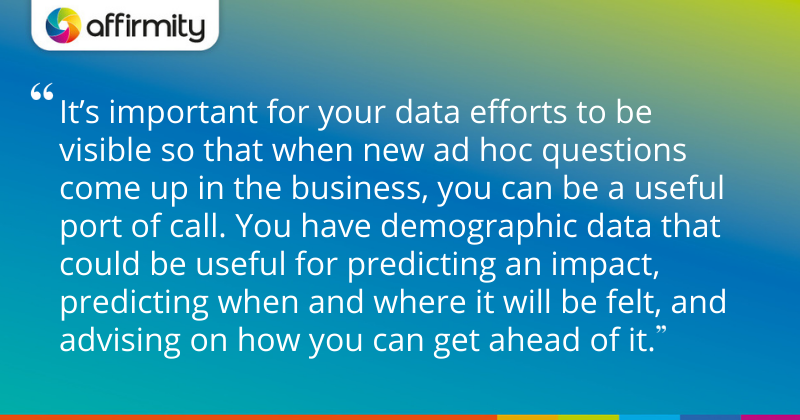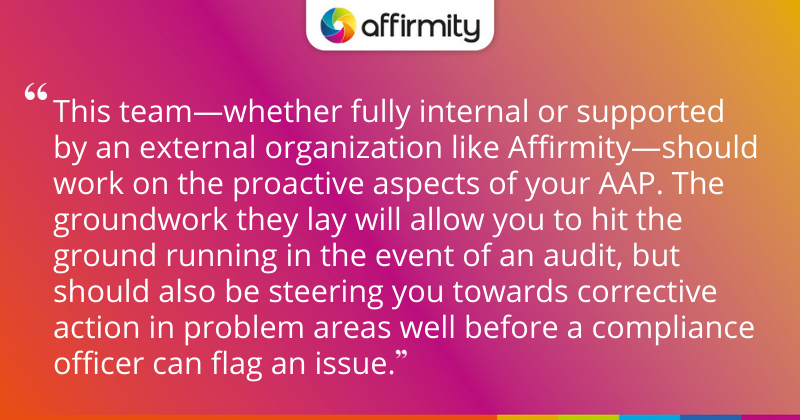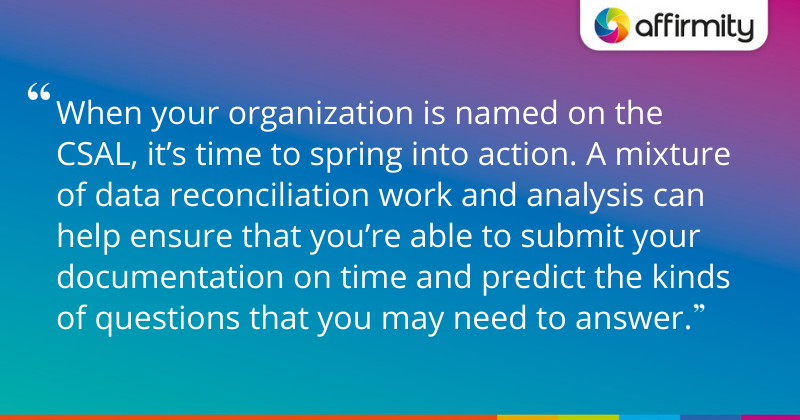If you’re building new data processes and collaboration opportunities within your business, don’t let all that hard work go to waste! Once you’ve started collecting affirmative action data, you’ll also need to settle into a pattern of maintenance and oversight—and not revert to an inefficient, siloed way of working. With a focus on remaining proactive, here are three ways and some additional ideas for sustaining and iterating upon affirmative action success.
One thing Affirmity likes to do with its customers is to work with them to schedule complementary analyses in conjunction to these activities. So at around the same time affirmative action planning is on the agenda—either as it begins or comes to a close—a pay equity study could be conducted, with the goal of proactively addressing an area of great risk with fresh data. Striking while the iron is hot, so to speak…

Beyond this, it’s important for your data efforts to be visible so that when new ad hoc questions come up in the business, you can be a useful port of call. For example, the organization may realize that it faces a loss of expertise in the near future because of a wave of retirements. You have demographic data that could be useful for predicting this impact, predicting when and where it will be felt, and advising on how you can get ahead of it.
Hopefully, this illustrates the proactive potential that your organization has. There are some costly penalties in compliance and other areas of the business, but there are also savings in terms of operational costs. Remember, just because there isn’t an authority fining you for bad practices, doesn’t mean that you aren’t wasting money!
Proactive Versus Reactive Program Maintenance: Recommended Activities
In recent years, we’ve seen a trend towards audit activity becoming tougher and more in-depth. This creates a workplace reality where you can never be too proactive—if an audit happens, the more you’re already doing, the better. Furthermore, tougher auditing practices are generally pushing organizations in a beneficial direction, even if it’s a somewhat painful process to get there.
With this in mind, we suggest undertaking the following recommended activities as part of your affirmative action efforts:

1) Assign Audit Support Teams
Before you’ve been selected for an audit, you should ideally assemble an audit support team. This team—whether fully internal or supported by an external organization like Affirmity—should work on the proactive aspects of your AAP. The groundwork they lay will allow you to hit the ground running in the event of an audit, but should also be steering you towards corrective action in problem areas well before a compliance officer can flag an issue.
LEARN MORE AUDIT TIPS | ‘Your Frequently Asked Questions and the Lessons We Learned From Working on OFCCP Audits’
2) Undertake Mock/Simulated Audits
What would happen if your organization was named on the Corporate Scheduling Announcement List (CSAL) within the next quarter? One way you could answer this question is to undertake a mock audit. The Affirmity team regularly conducts audit simulations and can look at your data, reporting, processes, website, and all of other relevant aspects of your business exactly as experience has shown the OFCCP will look at them. And where the mock audit uncovers issues and potential areas of concern, you can expect a comprehensive list of recommendations, rather than a fine!
3) Ready Your Pre-Submittal Audit Support Package

When your organization is named on the CSAL, it’s time to spring into action. A mixture of data reconciliation work and analysis can help ensure that you’re able to submit your documentation on time and predict the kinds of questions that you may need to answer. That work may include:
- Reconciling your applicant flow data
- Reconciling data and re-run analysis if needed
- Performing an Adverse Impact Analysis and Recommended Response Actions
- Performing a Multiple Regression Compensation Analysis
UNDERSTAND OFCCP AUDIT PREPARATION | ‘Tools and Processes to Help You Prepare for OFCCP Audits’
Additional Preparation and Products
In addition to the many reporting options available to you, this whole process is an opportunity to think about your talent management approach. From hire to exit, there are people making decisions. And that means there’s scope for human error, and business risk.
To address this risk, we recommend the following additional preparation:
- Talent Acquisition Compliance Assessment
- Equal Pay Studies
- Test Validation Analysis
- Employment Tests
- Pre-Screen Questionnaires
- Performance Rating Studies
- Wage/Hour Analysis and Training
- State Equal Pay Law Compliance
Bringing It All Together With Our Audit Manager
There are obviously a lot of different threads to bring together with this work. That’s why we’ve developed our CRC module within our online system that allows you to track, manage, and securely store all information required to address OFCCP audits. If you’re an organization that sees simultaneous audit activity, it provides a central place for coordinating your response.
A Suggested Timeline for Your Affirmative Action Program
Remember, your AAP isn’t something to shelve immediately after finishing. It’s an ongoing program. By planning this year in advance, you’ll avoid having to constantly react to things. The following timeline suggests one way to make this a reality:
- December: Project kickoff
- January: Data and compensation analysis
- March: Report preparation and review
- EEO-1 due date
- California reporting due date
- July: Monitoring
- September: VETS 4212
- Jan/Apr/Jul/Sep/Nov: Dissemination of reports and training to support understanding and action on the data
Other ongoing activities include:
- Outreach efforts
- Internal audits
- Audit preparation
MORE IDEAS FOR YOUR ONGOING PROCESS | ‘Driving DE&I: Where to Begin and How to Impact Real Change [Q&A]’
Create a Collaborative Approach to Affirmative Action Excellence—Keep Reading!
AAPs are packed with information that could be helping multiple people in your organization make better work decisions all year round—and with some tweaks to your process, you could achieve more besides. You’ll need to establish new methodologies and engagement strategies to complement the oversight tips above, and our full guide also considers:
- A look at how to leverage data analysis methodology and reporting to bridge internal data differences
- Pointers for building business engagement and accountability through regular updates, frequent tracking, and better interdepartmental relations
Download the full guide today.

